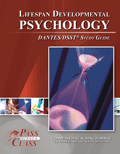Take a quick DANTES sample test with our FREE DANTES practice sample questions! These are a quick preview of what kind of information you'll be studying in our DSST Study Guide for this subject. You can also use these DANTES sample test questions to gauge how ready you are to take your DANTES test. How do you know when you are ready? A good way to tell is when you can flip open our DANTES study guide, put your finger on a page, any page, and be able to define and explain what it is you're pointing out. That takes effort. Studying for a DSST test does take effort, but based on your previous and current experience, there may be DANTES tests that you can take with little or no study. Taking a practice DANTES test can tell you if you are ready, it can give you an idea of the content of the DANTES test, it can tell you how difficult or easy your DANTES test will be.
Still learning about DANTES tests or you need more information than just a DANTES sample test? Visit our New Student Center to get a great overview of where to start.


Lifespan Developmental Psychology DANTES Practice Test
1) Which person believed that children were born a blank slate?
A) Jean-Jacques Rousseau
B) John Locke
C) Alfred Binet
D) Sigmund Freud
E) Erik Erikson
2) At what age will most children begin to identify which a/some specific best friend(s)?
A) 4 years old
B) 6 years old
C) 8 years old
D) 10 years old
E) 15 years old
3) Identity vs. Role Confusion is Erikson’s developmental stage which occurs while during which age?
A) Infant
B) Toddler
C) Preschooler
D) School-age child
E) Adolescent
4) Which of the following is an example of Maslow’s first level of needs?
A) Food
B) School
C) Car
D) Travel
E) Church
5) Ritalin is a well-known drug used to treat
A) Habituation
B) Object permanence
C) Hyperactivity
D) Divergence
E) Convergence
6) Which is NOT a step in the scientific method?
A) Gather information
B) Generate hypothesis
C) Test hypothesis
D) Revise
E) None of the above
7) According to Freud, at what age does the genital stage occur?
A) Birth to 1 year old
B) 1-3 years old
C) 3-6 years old
D) 6-11 years old
E) Adolescence
8) Which of the following is NOT an element of Vygotsky’s theory of social development?
A) A child must see the cultural aspect in society
B) A child must discuss the cultural aspect
C) The MKO
D) The ZPD
E) All of the above
9) Which of the following statements is FALSE?
A) The older a child becomes, the more specific and distinct the friendship circle grows.
B) When children are 10 years old they will generally begin to define one person as their best friend.
C) Young children often have generalized definitions of friends, such as “all the people in my class.”
D) Boys are much more likely than girls to form close friendships with other people.
E) All of the above
10) Social smile appears at how many weeks?
A) 2
B) 4
C) 7
D) 9
E) 13

Need more practice?
Our Lifespan Developmental Psychology DANTES Study guide has 136 MORE test questions to help you get ready for the test!
Lifespan Developmental Psychology DSST Practice Test Answer Key:
- 1. B:) John Locke.
- 2. D:) 10 years old. For girls especially, by the time they are ten, they will identify only one “best” friend.
- 3. E:) Adolescent.
- 4. A:) Food.
- 5. C:) Hyperactivity.
- 6. E:) None of the above.
- 7. E:) Adolescence.
- 8. B:) A child must discuss the cultural aspect. Vygotksy’s theory describes that the function occurs first outside, and then inside the child, but does not dictate that the child must discuss the aspect. The MKO and ZPD are elements of his theory however.
- 9. D:) Boys are much more likely than girls to form close friendships with other people. The truth is the exact opposite, girls are more likely to form close friendships.
- 10. C:) 7.